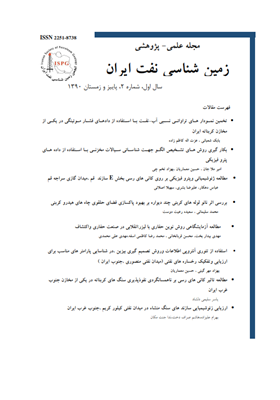تخمین نمودارهای تراوایی نسبی آب –نفت با استفاده از داده های فشار مویینگی در یکی از مخازن کربناته ایران
محورهای موضوعی :بابک شعبانی 1 , عزت اله کاظم زاده 2
1 - دانشگاه امیر کبیر
2 - پژوهشگاه صنعت نفت
کلید واژه: تراوایی نسبی فشار مویینگی فاز تر کننده فاز غیر تر کننده اشباع ومغزه ,
چکیده مقاله :
تراوایی نسبی را می توان با آزمایش مغزه های نفتی به صورت مستقیم محاسبه نمود ،ولی با توجه به عواملی چون عدم دسترسی به نتایج آزمایشگاهی اندازه گیری مستقیم تراوایی نسبی سیالات ،از روش های غیر مستقیم نیز برای اندازه گیری آن استفاده می شود .یکی از این روش ها ،تخمین نمودار های تراوایی نسبی با استفاده از داده های فشار مویینگی می باشد ودر ستی ان برای محاسبه تراوایی نسبی مایع –گاز، در سال های گذشته مورد بررسی قرار گرفته است ؛ولی هنوز اطلاعات کافی برای انتخاب بهترین مدل برای محاسبه تراوایی نسبی آب-نفت موجود نیست .در این مقاله از مدل های مختلفی چون Corey،Brooks-Corey،Li-Purcell،LI-Burdine برای محاسبه تراوایی نسبی آب –نفت با استفاده از داده های فشار مویینگی آب-نفت در فرایند تخلیه در یکی از مخازن کربناته نفت تر ایران استفاده شد .نتایج بدست آمده با داده های آزمایشگاهی تراوایی نسبی اب-نفت مقایسه شدند ومدل های Corey وBrooks-Corey مقادیر تقریباً دقیقی را برای محاسبه تراوایی نسبی نفت تخمین زدند .ولی مدل های Li-Purcell و LI-Burdineمقادیر کمتری را برای فاز تر کننده محاسبه کردند. همچنین ،به جز مدل Li-Purcell نتایج حاصل از سایر مدل ها برای تراوایی نسبی آب تقریباً یکسان است ودر اکثر موارد مقادیر بیشتری را نسبت به داده های آزمایشگاهی تخمین می زنند .سپس ،طبقه بندی مخزن با استفاده از اطلاعات شعاع منافذ مغزه در اشباع 35در صد از جیوه انجام شد ودقت هر یک از مدل ها برای هرگونه سنگی مورد بررسی وتفسیر قرار گرفت ؛نتایج حاصل از این کار نشان داد که تخمین نمودار های تراوایی نسبی آب-نفت با استفاده از دادهای فشار مویینگی می تواند به عنوان یک روش قابل قبول در محیط های کربناته نفت تر نیز ،مورد استفاده قرار گیرد .
Relative permeability can be measured directly from cores, but due to problems such as unavailability of experimental results of direct relative permeability measurement, indirect techniques also have been used to calculate relative permeability. One of these methods is estimating relative permeability curves from capillary pressure data that the reliability of this method for approximation of liquid-gas relative permeability curves had thoroughly investigated. However, there is not enough information to conclude which method is the standard one for calculating oil-water relative permeability curves. Various capillary pressure techniques such as the Corey, Brooks-Corey, Li-Purcell and Li-Burdine methods were utilized to calculate oil-water relative permeabilities using the measured oil-water capillary pressure data in drainage process in an oil-wet Carbonate reservoir. Despite wide popularity of Purcell and Burdine methods for calculating relative permeability, new Li-Purcell and LiBurdine methods were used. The calculated results were compared to the experimental data of oil-water relative permeabilities measured in a Carbonate reservoir. The Corey and Brooks-Corey models are shown an acceptable and nearly exact match with the measured oil relative permeability values. However, the Li-Purcell and Li-Burdine models underestimate the values for wetting phase in most cases. It is also worth mentioning that, except Li-Purcell method, the results of all other methods for calculating non-wetting phase relative permeability are almost the same and overestimate the values. Then, rock typing on the basis of pore throat radius at 35% mercury saturation were done and the accuracy of each model were examined for all rock types. Results of this work revealed that calculation of oil-water relative permeability using the capillary pressure data is also a reliable technique in oil-wet carbonate reservoirs.


